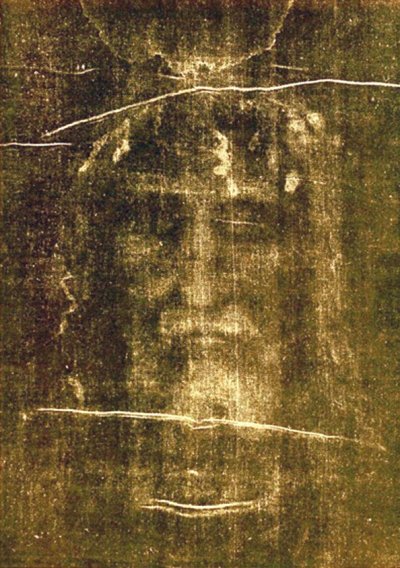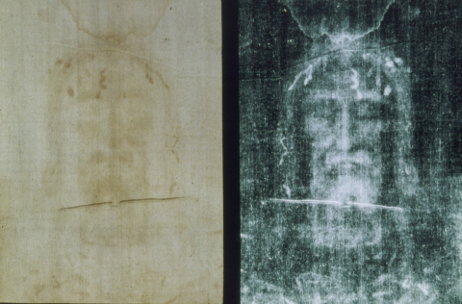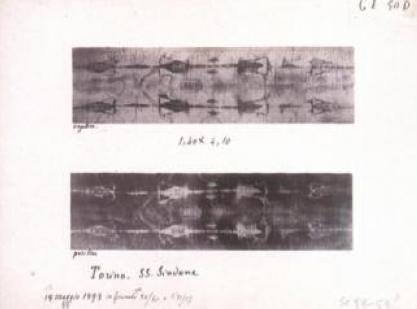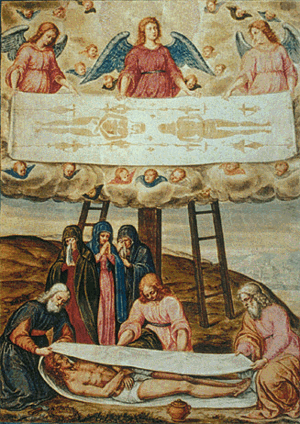The Shroud of Turin
Is this the face of Jesus?

Figure 1 - Is this the face of Jesus?
In 1898 a photo was made for the first time of a piece of cloth. This specific cloth was thought by some to have the image of Jesus on it.
The photo was developed, and on the negative there appeared a much clearer image! In fact, the negative looked more like a normal photo would, and the photo (as well as the cloth itself) looked more like a negative!
What you see in the first photo above is a negative of a photo, not the photo itself.
Below are the positive and negative, side-by-side, for comparison:

Figure 2 - Face on the Shroud
The image on the left is the actual image - what the cloth looks like. The image on the right is actually the negative of the photo on the left! True, the actual photo looks much more like a negative than the actual negative - which looks more like a photo!
Below is the original 1898 photo, and its negative: the first photo ever taken of the Shroud:

Figure 3 - First photo taken of the Shroud
The cloth contains more than a face - the cloth is approximately 14 feet long and 3 and a half feet wide, and contains 2 full length complete body images.
Below is a painting, Descent from the Cross with the Shroud of Turin, painted about 1625 by Giovanni Battista della Rovere ("Il Fiammenghino"), 1 in which you can see a piece of cloth that looks like the faint images in the 1898 photo. The lower part of the painting also illustrates how the cloth may have been wrapped around the body.

Figure 4 - painting, Descent from the Cross with the Shroud of Turin
The coroner and forensic medical pathologist for LA county, Dr. Robert Bucklin, examined and described the image. Dr. John H. Heller, a biophysicist who has served on the faculty of Yale University's medical school, recorded Bucklin's findings. Bucklin said the blood flow along the arms was in the 2 directions that were the only possible directions for blood to flow on a crucified individual. He also pointed out that the heart had been pierced by something like a lance or sword, and blood and clear serum had flowed out, with the serum even puddled underneath the body, under the back. He said the image on the shroud contained medical knowledge that was unknown 150 years previously. He made this statement during the 1970's. 2 The importance of this statement is, that if the shroud IS a forgery, as claimed based on C-14 dating (which will be dealt with later), then the Shroud still has to be MUCH older than the 150 years prior to the 1970's - hundreds of years older. The question then is, How did the forgers incorporate the medical knowledge into the image, hundreds of years before the knowledge existed?
But, the main puzzle is the image itself - how did it get on the cloth?
Was it pigment? One researcher said it was painted, on the basis of pigment found in a small sample of the cloth. Others have pointed out that over the centuries, paint, dust and other contaminants have made their way onto and into the shroud fibers. The real issue is whether the pigment makes up the image, not whether there are a few flakes of pigment here and there on the cloth.
And pigment does not make up the image. The STURP researchers found that the image was not made up of pigment. What is STURP?
A group of scientists examined the Shroud in 1978. They had a rare opportunity, and took over a million dollars worth of equipment to Turin. They decided, after some thought, to call themselves the Shroud of Turin Research Project - STURP.
This was the first time such a detailed examination of the shroud had occurred, in all of its hundreds of years of existence (even those claiming it was a forgery, based on C-14, admit to its being centuries old). Only rarely was the shroud even displayed for public viewing, much less for experimentation. In 400 years, it was on display only 11 times.
So, some scientists jumped at the opportunity to examine this object. They came from JPL (Jet Propulsion Laboratory), the Air Force Academy, etc. and were experts in various fields - physics, optics, etc. After examining the shroud, they and other scientists spent more time analyzing the resulting data.
History
This cloth has been known for centuries. It's known history goes back to Geoffrey de Charnay.
Before Geoffrey de Charnay, there are question marks about its history.
But there is evidence of its existence as early as the 6th and 7th centuries.
Why does that matter?
Carbon 14 dating tests were done on the shroud, and the claim was made that the dating showed the shroud originated around 1300. This, if true, would imply the shroud might not be the burial shroud of Jesus.
But if the shroud can be shown to have existed earlier, then the carbon 14 dating would be invalidated and the possibility of the shroud's being the actual burial shroud of Jesus would remain.
6th and 7th century pictures, including images on coins, bear remarkable resemblance to the shroud image. Even the line crossing the neck area near the bottom of the chin, on the shroud image, appears on some early pictures of Jesus.
Dr. Alan Whanger has pointed out the existence of many similarities between these early images and the shroud image. The implication is that these pictures were based on the shroud image - copied from the shroud image.
Carbon Dating Invalidated
Well, what about the carbon dating? Experts now are tending more towards the conclusion that the carbon 14 dating was invalid. Why?
The carbon 14 dating involved removing a small sample of cloth from the shroud to be tested. This sample was from an area of the shroud that had indications of being rewoven. In fact, it has now been reported that this sample contained only 40% original shroud material, and 60% extraneous material. 3
In light of the compelling evidence that we are about to present, we believe that the theory that the Shroud has literally been patched with medieval material from the 16th century, in the C-14 sample itself, explains the medieval carbon dating results.
Furthermore, several other sindonologists have identified various anomalies that also seem to point to undocumented repairs (Gervasio, 1986: 264, 268), which adds credence to the hypothesis that the C-14 sample area may have been similarly enhanced.
This would distort the dating. It's like the attempt to find the average age of 20 people who work for a company, but before the averaging is done, a group of nursery school children is added to the group. Obviiously, this will cause the average age to be younger.
This is precisely what happened with the carbon dating. The extraneous material, like the nursery school children, mixed in with the older shroud material, caused the average age of the sample to be much younger than the original shroud material alone.
We read in an article by Ray Rogers 4 that not only the sample was invalid, but that the date is older in reality than the 1988 botched C-14 dating.
To clarify some of the problems with the sample, see the following quote from www.shroud2000.com:
Further investigation by Anna Arnoldi of the University of Milan and Ray Rogers, using ultraviolet photography and spectral analysis, show that the area from which the samples were taken was chemically unlike the rest of the cloth. Analysis reveals the presence of Madder root dye and an aluminum oxide mordant (a reagent that fixes dyes to textiles) and is not found elsewhere on the Shroud. The presence of Madder root and mordant suggests that the Shroud was mended in the carbon 14 sample area. Flax fibers from a probable repair made in the 1500's were lighter in color than the threads from the original Shroud. The root dye was used to blend in the color to make it match with the darker Shroud.
One of the samples taken from that area of the Shroud also shows cotton twisted in with the flax. This also is atypical versus the rest of the cloth. Microchemical tests also reveal vanillin (C8H8O3 or 4-hydroxy-3-methoxybenzaldehyde) in this same sample area. The rest of the cloth does not test positive for it. Vanillin is produced by the thermal decomposition of lignin, a complex polymer, a non-carbohydrate component of plant material including flax. Vanillin is found in medieval materials but not in much older cloths, it diminishes and disappears over time. For instance, the wrappings of the Dead Sea scrolls do not test positive for vanillin. 5
So, vanillin should be present in cloth as old as medieval times - and was in the questionable area tested. Material older than medieval times would not contain vanillin - and vanillin was not found in the rest of the Shroud. This indicates the rest of the Shroud is older than the area that was carbon-dated.
A sewing expert, Flury-Lemberg 6 , has examined the stitching on the shroud, and claimed the only time she knows of when such stitching was in use, was about 2000 years ago - in the region near Israel.
Is there blood on the cloth?
Some have claimed that there is no blood on the shroud. Dr. Heller, a biophysicist, who was on the faculty of Yale University's medical school, says there was blood on the Shroud. It even has been typed - type AB.
Dr. Heller said that he thought that if every piece of wood from the true cross were gathered together, you would have a lumberyard. 7 He was skeptical about the authenticity of so-called relics. And there have been hoaxes and fakes. But this particular scientist, Dr. Robert Heller, became convinced of the authenticity of the shroud.
Why - what convinced him - as well as many others?
Could it Have Been Forged?
There are several reasons that the image could not have been made by man. The difficulties of creating such an image included the following:
- drawing the image as a reversed negative; i.e., drawing the inverse of what the photos show. How difficult would YOU find it to draw a negative image of a person, so that when a photo of your drawing is made, and the negative produced, the negative would look like the person you were trying to draw?
- the lack of directionality or brush strokes in the image. Computer analysis, using a mathematical technique called a 2-dimensional spatial Fourier transform of the image, revealed no evidence of brush strokes. If an artist had painted an image, there would be evidence of brush strokes that would show up in this kind of analysis. 8
- the lack of pigment. 9 The image itself, the scientists found, did not consist of pigment applied to the cloth fibers.
- the chemical alteration of the fibers. The fibers themselves had been changed, in their chemical structure, which altered their color. This would have been difficult - virtually impossible - for an artist to do. Even the scientists were puzzled, and had difficulty explaining what could have caused such a chemical change in the fibers. Their best hypothesis was some kind of radiation. Radiation was not easily produced in the 1300's, the claimed carbon dating time of the shroud's forgery!
- the coloring of only the top part of the fibers. It is again, virtually impossible to apply a pigment or otherwise color to, not the entire fiber, but only the top part (also, remember, there was no pigment forming the image).
- inclusion of X-ray-type information in the image. There are faint outlines of bones - if you look carefully at the hands, the fingers seem extraordinarily long. The fingers are not what is long - the bones of the hand which extend beyond the fingers into the hand, are what make the fingers look so long.
- the 3-dimensional information in the image. Not only is the image a negative instead of a positive image, but the image contains 3-dimensional information that is simply not contained in other photos - of faces. The scientists, Heller, for one, expressed amazement at the inclusion of 3-d information in the image. Yet, the existence of this was confirmed by a VP-8 Image Analyzer, which was used with NASA images from space. The inventor of the NASA VP-8 Image Analyzer said this:
Jackson placed an image of the Shroud of Turin onto the light table of the system. He focused the video camera of the system on the image. When the pseudo-three-dimensional image display ("isometric display") was activated, a "true-three-dimensional image" appeared on the monitor. At least, there were main traits of real three-dimensional structuring in the image displayed. The nose ramped in relief. The facial features were contoured properly. Body shapes of the arms, legs, and chest, had the basic human form. The result from the VP-8 had never occurred with any of the images I had studied, nor had I heard of it happening during any image studies done by others.
I had never heard of the Shroud of Turin before that moment. I had no idea what I was looking at. However, the results were unlike anything I have processed through the VP-8 Analyzer, before or since. Only the Shroud of Turin has produced these results from a VP-8 Image Analyzer isometric projection study. 10
- Artists have attempted to recreate this type of 3-d information in a negative image, quite unsuccessfully.
- Leonardo da Vinci was too young or not yet born, so could not have created it. Some theories have emerged, claiming that da Vinci created the image on the shroud. But there is a problem with the time frames - he was too young or not even born.
Summary
Science has not been able to prove the Shroud a fake. On the other hand, while admittedly there have been fakes, hoaxes and forgeries, there are mysteries about its formation which leave one with seemingly no rational explanation, other than the miraculous. Attempts still being made to explain the formation of the image by natural processes notwithstanding, the evidence seems to indicate that science has no explanation.
Dr. Heller reports, at a press conference with over 300 media representatives in attendance, STURP was asked: "... do you think it is authentic?" The scientists said they could not say; one said it could have been made miraculously by elves, for all they knew.
The scientists only stated what they could prove.
One person asked, "All who believe this is the authentic Shroud of Christ, raise your hands." 40 scientists just looked at him. Then he asked, "... all those who don't believe it's authentic, raise your hands." Again, forty scientists sat still; none moved. Quoting Heller:
At that point, one of the real people asked, "Have you found anything that would preclude the Shroud's being authentic?"
"No."
...
We told the audience what the image was made of - dehydrative oxidation of the linen with the formation of a yellow carbonyl chromophore.
Then, of course, came the other question that we had been wrestling with for nine months: "How did the image get on the cloth?"
We answered ... all the possibilities we had been able to dream up ... we had had to reject all of them, one by one.
"Where," we were asked, "does that leave you?"
"We just do not know."
And that is the nub of it. ... at least four hundred scientists had added their input. In addition, all of us had given lectures ... Sigma Xi, ... the American Chemical Society, at universities across the country and their alumni groups, such as MIT's, at meetings of other scientific societies - from physical engineering to the medical sciences. From all of these we had received contributions of knowledge and suggestions. But on the subject of how the body images got on the Shroud, every suggestion had been invalidated by the data.
The Shroud remains, as it has over the centuries, a mystery." 11
- 1della Rovere, Descent from the Cross with the Shroud of Turin http://commons.wikimedia.org/wiki/File:OntstaanLijkwade_GiovanniBattista.png Accessed 2008 Mar 28
- 2Report on the Shroud of Turin, Dr. John H. Heller, Professor of Internal Medicine at Yale University, Houghton Mifflin, 1983, Boston, pp. 2-4
- 3http://www.shroud.com/pdfs/marben.pdf
- 4Thermochimica Acta (Volume 425 pp. 189-194, by Raymond N. Rogers, Los Alamos National Laboratory, University of California)
- 5 http://shroud2000.com/LatestNews.htm Accessed 2009 Mar 28
- 6 http://www.pbs.org/wnet/secrets/previous_seasons/case_shroudchrist/interview.html Accessed 2009 Mar 28
- 7Heller, p. 5
- 8Heller, pp. 34-35
- 9Heller, p. 198
- 10Photogrammetric Responses From The Shroud of Turin, Peter M. Schumacher, http://www.shroud.com/pdfs/schumchr.pdf Accessed 2009 Mar 28
- 11Heller, pp. 216-218